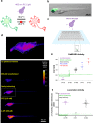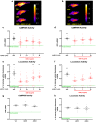Medium-throughput zebrafish optogenetic platform identifies deficits in subsequent neural activity following brief early exposure to cannabidiol and Δ9-tetrahydrocannabinol
- PMID: 34075141
- PMCID: PMC8169761
- DOI: 10.1038/s41598-021-90902-3
Medium-throughput zebrafish optogenetic platform identifies deficits in subsequent neural activity following brief early exposure to cannabidiol and Δ9-tetrahydrocannabinol
Abstract
In light of legislative changes and the widespread use of cannabis as a recreational and medicinal drug, delayed effects of cannabis upon brief exposure during embryonic development are of high interest as early pregnancies often go undetected. Here, zebrafish embryos were exposed to cannabidiol (CBD) and Δ9-tetrahydrocannabinol (THC) until the end of gastrulation (1-10 h post-fertilization) and analyzed later in development (4-5 days post-fertilization). In order to measure neural activity, we implemented Calcium-Modulated Photoactivatable Ratiometric Integrator (CaMPARI) and optimized the protocol for a 96-well format complemented by locomotor analysis. Our results revealed that neural activity was decreased by CBD more than THC. At higher doses, both cannabinoids could dramatically reduce neural activity and locomotor activity. Interestingly, the decrease was more pronounced when CBD and THC were combined. At the receptor level, CBD-mediated reduction of locomotor activity was partially prevented using cannabinoid type 1 and 2 receptor inhibitors. Overall, we report that CBD toxicity occurs via two cannabinoid receptors and is synergistically enhanced by THC exposure to negatively impact neural activity late in larval development. Future studies are warranted to reveal other cannabinoids and their receptors to understand the implications of cannabis consumption on fetal development.
Conflict of interest statement
The authors declare no competing interests.
Figures




References
Publication types
MeSH terms
Substances
LinkOut - more resources
Full Text Sources
Molecular Biology Databases

